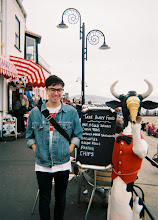Tuesday, 4 May 2010
Final Post
Monday, 3 May 2010
Darkroom Prints

Ideally I would have blown these images up to life-size too, had I the time and photographic paper to do so. I don't feel that the 10x8 size quite does them justice but for the time being it is a reasonable substitute.
Full Scale Colour Print

Thursday, 29 April 2010
Belated Video Stills Post 3



Belated Video Stills Post 2


Belated Video and Stills Post 1



Friday, 23 April 2010
Polaroids in Colour and Black and White



The first few were in colour, finishing off the pack of film I had in previously, the second series, which can be seen further down the page, were taken with a high-iso black and white film. I had hoped that, with using the 3000 iso black and white film that they would yeild somewhat grainier results, more like my previous Bronica images, unfortunately this was not the case, not that I was particulary disappointed with the images I did manage to capture. The lack of large-grain despite the fast film speed may be due to the limited size of the images, 31/4" x 41/4", and the process of making the Polaroid is more or less a contact-print, rather than an enlargement as you would get from a conventional film.

.jpg)
